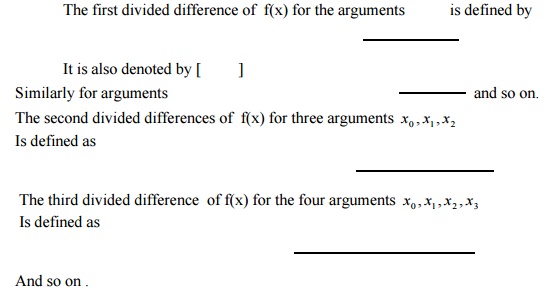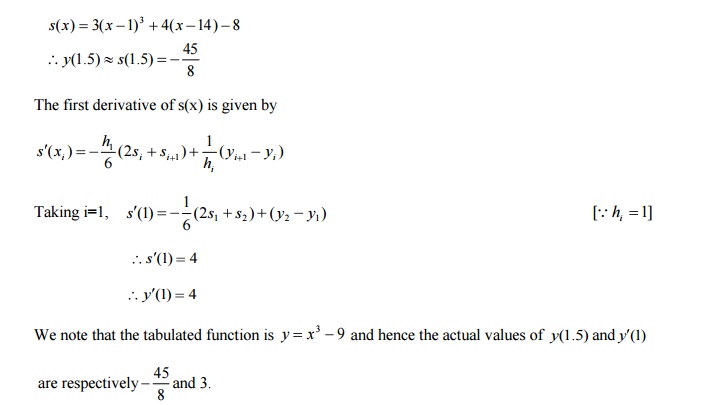Chapter: Mathematics (maths) : Interpolation and Approximation
Interpolation And Approximation
INTERPOLATION AND APPROXIMATION
1
Interpolation with Unequal Intervals
Lagrange`s Interpolation formula
Inverse Interpolation by Lagrange`s Interpolation
Polynomial
2
Divided Differences-Newton Divided Difference Interpolation
Divided Differences
Newtons Divided Difference formula for unequal
intervals
3
Interpolating with a cubic spline
Cubic spline interpolation
4
Interpolation with equals
Newtons` forward interpolation formula
Newtons` Backward interpolation formula
1 Interpolation with
Unequal intervals
Introduction
Interpolation is a
process of estimating the value of a function at ana intermediate point when
its value are known only at certain specified points.It is based on the
following assumptions:
(i)
Given equation is a polynomial or it can
be represented by a polynomial with a good degree of approximation.
(ii)
Function should vary in such a way that
either it its increasing or decreasing in the given range without sudden jumps
or falls of functional values in the given interval.
We shall discuss the concept of interpolation from a
set of tabulated values of when the values of x are given intervals or at
unequal intervals
.First
we consider interpolation with unequal intervals.
Lagrange’s
Interpolation formula

This is called the for Interpolation Lagrange’s. formula
Problems
1.Using Lagrange’s interpolation find the
value of y-corresponding formula, to x=10 from the following data


Using x=10 and the given data, y (10)
=14.67
2. Using Lagrange’s interpolation
forfromula,the fi following data
X 3 7 9 10
Y 168 120 72 63
Sol:
Given
By Lagrange’s interpolation formula

Using x=6 and the given data, y(6)=147

Using x=5 and the given data, y(5)=32.93
Exercise
1.Find the polynomial degree 3 fitting
the following data
X -1 0 2 3
Y -2 -1 1 4
Ans:
2.Given
Ans:
Inverse Interpolation by
Lagrange’s interpolating
Lagrange’s
interpolation formula can be used is not in the table. The process of finding
such of x is called inverse interpolation.
If x is the dependent variable and y is
the independent variable, we can write a formula for x as a function of y.



2
Divided Difference –Newton Divided Difference Interpolation Formula
Introduction
If the values of x are
given at unequal intervals, it is convenient to introduce the idea of divided
differences. The divided difference are the differences of y=f(x) defined,
taking into consideration the changes in the values of the argument .Using
divided differences of the function y=f(x),we establish Newton’s which divided is used for
different interpolation which the values of x are at unequal intervals and also
for fitting an approximate
curve for the given data.
Divided difference
Let the function assume the values
Corresponding to the arguments x1 , x2 , x3 ,..... xn respectively, where the
intervals need to be equal.
Definitions
The first divided difference of f(x) for the arguments is defined by




3 Interpolating with a
cubic spline
cubic spline
Interpolation
We consider the problem of interpolation between given data points (xi, yi), i=0, 1, 2, 3….n where

by means of a smooth polynomial curve.
By means of method of
least squares, we can fit is the new technique recently developed to fit a
smooth curve passing he given set of points.
Definition of Cubic spline
A cubic spline s(x) is defined by the following
properties.
S(xi)=yi,i=0,1,2,…..n
S(x),s’(x),s”(x) are
continuous on [a,b]
S(x)
is a cubic polynomial in each sub-interval(xi,xi+1),i=0,1,2,3…..n=1
Conditions for fitting spline fit
The conditions for a cubic spline fit
are that we pass a set of cubic through the points, using a new cubic in each
interval. Further it is required both the slope and the curvature be the same
for the pair of cubic that join at each point.
Natural cubic spline
A cubic spline s(x) such that s(x) is
linear in the intervals

i.e.
s1=0 and sn=0 is called a natural cubic spline
where s1 =second
derivative at (x1 , y1 )
sn
Second derivative at (xn ,
yn )
Note
The
three alternative choices used are

with
the assumption, for a set of data that are fit by a single cubic equation their
cubic splines will all be this same cubic

Problems
1.Fit
a natural cubic spline to the following data
x 1
2 3
y -8
-1 18
And
compute (i) y(1.5) (ii) y’(1)
Solution

For
equally spaced intervals,the relation on s1 , s2 & s3 is given by


2.The following values of x and y are
given ,obtain the natural cubic spline which agree with y(x) at the set of data
points
X 2 3 4
Y 11 49 123

Hence
compute (i) y(2.5) and (ii) y’
(2)
Exercise:
1.Fit
the following data by a cubic spline curve
x 0 1 2 3 4
y -8 -7 0 19 56
Using
the end condition that s1 & s5 are linear extrapolations.

4 Interpolation with equal
intervals
(Newton’s Forward and Backward Difference
formulas)
Introduction
If a function y=f(x) is not known explicitly
the value of y can be obtained when s set of


This
formula is called Newton Backward interpolation formula.
We
can also use this formula to extrapolate the values of y, a short distance
ahead of yn.
Problems
1.Using
Newton’s Forward interpolation formula
X
1.0 1.1 1.2 1.3 1.4
F(x)
0.841 0.891 0.932 0.964 0.985
Sol:
Forward difference table:

y(27)=24.8
4.Find the cubic polynomial which takes the
value y(0)=1,y(1)=0,y(2)=1,y(3)=10.Hence or otherwise ,obtain y(4).Ans:y(4)=33
Exercise: 1.Given the data

x 0 1 2 3 4
y 2 3 12 35 78
Find the cubic function of x,using Newton’s backward interpolation formula

Ans:6.3601
4.Find the polynomial which passes through the point newton's (7,3)(8,1)(9,1)(10,9) using interpolation formula.
Tutorial
Problems
Tutorial
1
1.Apply Lagrange’s formula inversely to
obtai f(0)=-4,f(1)=1,f(3)=29,f(4)=52.
Ans:
0.8225
2.Using
Lagrange’s formula of
interpolation ,
X 7 8 9 10
Y 3 1 1 9
Ans:
3.625
3.Use
Lagrange’s formula to
find the value
of
x 3 7 9 10
y 168 120 72 63
Ans:
147
4.If
log(300)=2.4771,log(304)=2.4829,log(305)=2.4843,log(307)=2.4871find log(301) Ans:
2.8746



Part
A
1.
State the Lagrange’s. interpolation formula
Sol:
Let
y = f(x) be a function which takes the values y0, y1,……n y-corresponding
to x=x0,x1,……nx
Then
Lagrange’s interpolation formula
is
Y = f(x) = --- --
2.
What is
the assumption we
make when Lagran
Sol:
Lagrange’s interpolation formula can be
used whether the values of x, the independent variable are equally spaced or
not whether the difference of y become smaller or not.
3.
When Newton’s
backward interpolation formu
Sol:
The formula is used mainly to
interpolate the values of y near the end of a set of tabular values and also
for extrapolation the values of y a short distance ahead of y0
4. What
are the errors in Trapezoidal rule of numerical integration?
Sol:
The
error in the Trapezoidal rule is
E<
---- y”
![]()
5.Why Simpson’s
one third rule
is called a c
Sol:
Since the end point
ordinates y0 and yn are included in the Simpson closed
formula.
6. What
are the advantages
of Lagrange’sformula? formul
Sol:
The forward and
backward interpolation formulae of Newton can be used only when the values of
theindependent variable x are equally spaced and can also be used when the
differences
of the dependent
variable y become smaller ultimately. But Lagrange’s interpolati be used
whether the values of x, the independent variable are equally spaced or not and
whether
the difference of y become smaller or not.
7. When do
we apply Lagrange’s
interpolation?
Sol:
Lagrange’s
formulainterpolcationbe used when the val not. It is mainly used when
the values are unevenly spaced.
8. When do
we apply Lagrange’s
interpolation?
Sol:
Lagrange’s
interpolation formula spacedcanor be us not. It is mainly used when the values
are unevenly spaced.
9. What are
the disadvantages in
practice in ap
Sol:
1. It
takes time.
2. It
is laborious
10.
When Newton’s
backwardformulaisused.
interpolation
Sol:
The formula
is used mainly
to interpolate
values.
11.
When Newton’s
forward interpolation formu
Sol:
The formula is used
mainly tobeginniginterpolateofsetof tabular values.
12.
When do
we use Newton’s
divided differenc
Sol: This
is used when the data are unequally spaced.
13. Write
Forward difference operator.
Sol:
Let y = f (x) be a
function of x and let of the values of y. corresponding to of the
values of x. Here, the independent variable (or argument), x
proceeds
at equally spaced intervals and h (constant),the difference between two
consecutive values of x is called the interval of differencing. Now the
forward difference operator is defined as

These
are called first differences.
14.Write
Backward difference operator.
Sol:
The
backward difference operator is defined as
These
are called first differences
Part
B
1.Using Newton’s
divided difference and hence
formula, find f(4).
X 0 1 2 5
f(x) 2 3 12 147
2.Find
the cubic polynomial which takes the following values:
X 0 1 2 3
f(x) 1 2 1 10
3.The
following values of x and y are given:
X 1 2 3 4
f(x) 1 2 5 11
Find
the cubic splines and evaluate y(1.5) and y’(3).
4.Find
the rate of growth of the population in 1941 and 1971 from the table below.
Year
X 1931 1941 1951 1961 1971
Population 40.62 60.8 79.95 103.56 132.65
Y
5.Derive Newton’s backward
difference formula
6.Using Lagrange’s interpolation formula
fin
(0,-12),(1,0),(3,6),(4,12).
7.Using Newton’s
divided difference formula
X 0 1 2 4 5
f(x) 1 14 15 5 6
8.Obtain
the cubic spline approximation for the function y=f(x) from the following data,
given that y0” 3=”=0y.
X -1 0 1 2
Y -1 1 3 35
9.The
following table gives the values of density of saturated water for various
temperatures of saturated steam.
Temperature0
C 0 100 150 200 250 300
Density
hg/m3 958 917 865 799 712
Find
by interpolation, the density when the temperature is 2750 .
10.Use Lagrange’s10656
method,giventhatlog 10to654 =2find.8156, log log 10 658
=2.8182 , log 10 659 =2.8189 and log 10 661 =2.8202.
11.Find f’(x) at x=1.5 and x=4.0 from the fol
differentiation.
x 1.5 2.0 2.5 3.0 3.5 4.0
Y=f(x) 3.375 7.0 13.625 24.0 38.875 59.0
12.If
f(0)=1,f(1)=2,f(2)=33 and f(3)=244. Find a cubic spline approximation, assuming
M(0)=M(3)=0.Also find f(2.5).
13.Fit
a set of 2 cubic splines to a half ellipse described by f(x)= [25-4x2]1/2.
Choose the three data points (n=2) as (-2.5,0), (0,1.67) and (2.5 , 0) and use
the free boundary conditions.
14.Find
the value of y at x=21 and x=28 from the data given below
x 20 23 26 29
y 0.3420 0.3907 0.4384 0.4848
15.
The population of a town is as follows:
x
year 1941 1951 1961 1971 1981 1991
y
population 20 24 29 36 46 51
(thousands)
Estimate
the population increase during the period 1946 to1976.
Related Topics